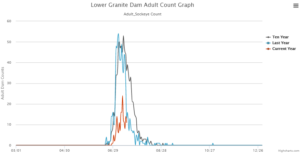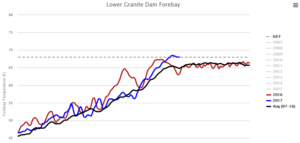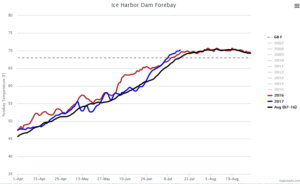State of the Snake 07/17/17
Posted /UncategorizedThe State of the Snake River
It’s the middle of July, 2017. How is the salmon migration going? A few lawmakers in the Pacific Northwest have been telling us how great the salmon recovery is going and how valuable the four lower Snake River dams are to the nation. Let’s take a look at the numbers, as reported by the Fish Passage Center (fpc.org).
Salmon returns to Lower Granite dam, the uppermost of the four lower Snake dams are as follows:

Spring Chinook
2017: 27,357 (44% of 10 year average)
2016: 62,050
10 yr avg: 62,403
Summer Chinook
2017: 7,488 (50% of 10 year average)
2016: 9,388
10 yr avg: 15,008

Sockeye salmon
2017: 179 (26% of 10 year average)
2016: 682
10 yr avg: 699
Hmmmm… don’t see any records here.
Down at Ice Harbor dam, the farthest downstream of the four lower Snake dams, the yearly steelhead run is starting. Maybe we’ll see some records there.

Steelhead
2017: 1,443 (15% of 10 year average)
2016: 4,240
10 yr avg: 9,688
Wow, definitely not a record. Unless you are talking about record lows.

What does the future hold?
So, should we expect a recovery this year? Probably not. Temperatures in the Snake River at Lower Granite dam have hit 78 F on the surface already, and are 68 F at a depth of 20 m where the water is drawn for the fish ladders. Salmon like cool water and this hot water slows their migration and can even cause death. Attempts by the Army Corps of Engineers to keep the water below 68 F have been unsuccessful. Dworshak dam on the Clearwater River is normally used to cool the Snake River by passing water through it’s turbines.
This year those efforts are hampered because the largest turbine is out of service.

If they spill water instead, it drives up the dissolved gas levels which can be toxic to salmon and steelhead, especially juveniles. So the Corps faces a dilemma… spill water to cool the adult salmon in the Snake River but potentially poison all the juvenile fish at the Dworshak fish hatchery, or not spill water to save the hatchery juveniles but potentially kill the adults migrating in the Snake.
It’s a rotten situation that the US Army Corps has placed itself and the salmon in. There is still one alternative that the Corps has, but is unwilling to try. That would be Alternative 4 in the 2002 EIS, the EIS under which they are currently operating the dams. Alternative 4 involves drawing down the reservoirs and returning the Snake to a free flowing river. It is the only way to save the Pacific Northwest’s salmon. But the US Army Corps of Engineers seems perfectly content with allowing the extinction of the remaining salmon and steelhead stocks.
